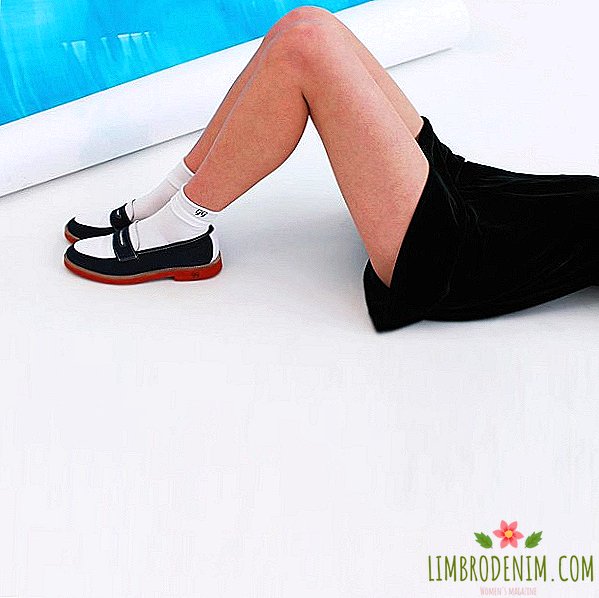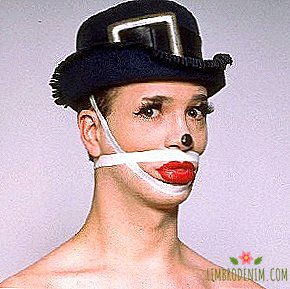Dance historian Vita Khlopova about favorite books
IN BACKGROUND "BOOK SHELF" we ask journalists, writers, scholars, curators, and other heroines about their literary preferences and publications, which occupy an important place in their bookcase. Today, the historian of dance, the researcher of modern choreography and the creator of the project No fixed points Vita Khlopova shares her stories about favorite books.

 I am the only child in the family and, being a bit of an introvert, I enjoyed reading. I was one of those who always bumped into a pole on the street, because I was buried in a book. Frequent memories from childhood: I wake up at three in the morning with my dad in my arms, and my mother makes me a bed - I always fell asleep while reading a book.
I am the only child in the family and, being a bit of an introvert, I enjoyed reading. I was one of those who always bumped into a pole on the street, because I was buried in a book. Frequent memories from childhood: I wake up at three in the morning with my dad in my arms, and my mother makes me a bed - I always fell asleep while reading a book.
At nine years old, my life has changed dramatically. I entered the Moscow Ballet School. Classes were held from nine in the morning to six in the evening at Frunzenskaya, but I lived in Zelenograd, and in order to be in school at around 8:30, I had to get up at 5:40. I came home at about nine, then an hour of music lessons, an hour — lessons, an hour — stretching and gymnastics. As a result, I fell asleep at one in the morning. Therefore, I was sent to a boarding school for nonresident pupils (I still scare my new acquaintances with the word "boarding school", but in fact it was just a hostel). And even though I began to sleep more than four hours, I could no longer read, as before, because of the incredible workload.
The school "gave" a stereotype, getting rid of which led me to the current profession: all ballerinas are stupid. The teachers said this, the friends of the parents spoke, my new non-ballet acquaintances said it later. “If there was a ballerina on the Titanic, he would not have drowned, because the ballerina is like a cork,” I had heard plenty of stories like that. Therefore, from the age of ten I firmly decided that I would prove to everyone that the ballerinas are not stupid. I carried with me a deliberately many books in my hands, so that the cover was always visible. I read that it was still too early to read, in order to "wipe the nose" to the teachers, who again said that we were stupid.
When I entered GITIS at the theater faculty, I realized that I was absolutely categorically uneducated. My classmates already then, at seventeen, were discussing Bart, and I had never even heard of him. I was terribly angry at myself and at my ballet education. The first semester, some of my fellow students frankly laughed at me: my critical experiences were extremely naive and full of silly journalistic clichés. But by the end of my studies, it turned out that only I had somehow graduated from the red diploma, and only I was invited to graduate school.
Just a couple of years, I went to study in Paris. The first shock was the library center Pompidou. Firstly, there are no library cards in it, and secondly, you can take with you the whole backpack, and not pull out, in order to get past, a pencil and a couple of pieces of paper. You can sit there until ten o'clock in the evening, and when you get tired, you can go to a cafe or breathe on the balcony (from the balconies in Pompidou it looks like five minutes is enough for a new portion of inspiration). For a year I studied the whole section of modern dance in the Pompidou, and I had to look for a more specialized place. I found the Dance Center, which is located in a not very favorable area, quite far from the center, and the view from the balcony no longer inspired.
I watched a video clock, reprinted hundreds of books; librarians compiled a program for me, pulled out archives, helped with translation. It seemed as if she woke up after a hundred-year coma and was trying to understand in a couple of years what had happened in those hundred years. Two years spent in that center gave me all the basic knowledge that I had not gained in fifteen years of studying ballet in Russia. I was leaving France with a margin of sixty kilograms. I have more than three hundred foreign books on choreography, and this is only the cream - the rest of the nonsense I have already managed to sell in France. I will not speak about ballet books in Russian - this baggage has been accumulated since the time of the school.
Every time I travel, I look for second-hand books; there you can find treasures for pennies: diaries of Nijinsky for fifty cents or the rarest book about The Spring of Sacred for two euros I took in a secret shop at a flea market in Paris. In New York, I went around all the bookstores and made a huge guide to the best dance book points, but in the end I thought that there were no more people like me crazy about one topic and no one would read it. Now it seems to me that I read indecently little. Moreover, before each lecture I study several books, some have to be swallowed whole in a couple of days. But as they relate to my professional interests, I do not consider them as "real" reading.
I always take the Kindle with me. I bought it, even when I started giving lectures at GITIS: preparation was exactly one week, and if the topic was narrow, for example, “The Third Generation of Modern Dance in America,” only the corresponding book could save me: the electronic version could be downloaded instantly and it cost cheaper. For a couple of years, a decent amount of books on dance gathered in my Kindle library, and when the course was over, I downloaded a ton of interesting books not related to choreography. I usually read several books in parallel in the Kindle, I often sin by doing it diagonally, but I still learn to do it more slowly. Now I am trying to read the diaries of Sarah Bernard without haste and carefully, but this is very difficult: such a narcissistic and sassy tone still needs to be endured, and the book itself is huge.

Polanski's novel
"Angelin Preljocaj"
Angelin Preulzhokazh is a person who turned me from a ballet dancer into a researcher of modern choreography, and because of him I ended up at the Sorbonne. When I studied at GITIS, we did not have a history of ballet, but I heard about the courses on the history of modern choreography at the Institute of Contemporary Art (Institute of Contemporary Art), which Violetta Maynietse taught, she later became my guide to this research world. At one of the first lectures she showed “Romeo and Juliet” a choreographer with a strange name, and I was dumbfounded that the ballet was not staged at all on Shakespeare, but on Orwell’s “1984”.
From that moment I began to study Preljocaj, and I chose him for a diploma, having found out, however, a month before the defense that nothing was written about him in Russian. I had to take courage and write to him personally. A couple of hours later, a letter arrived that on April 9, Monsieur Prulzhokazhka was waiting for me in his studio for an interview. Quite a lot of books have been written about him, as he is one of the most important choreographers of France, but this one is my favorite. When director Roman Polanski asks a question to choreographer Angeline Prelzhokazhu - this is already interesting. And the main thing is that Polansky's questions tell a lot about him as well, which makes this book interesting not only for lovers of modern dance.
Nancy Reynolds, Malcolm McCormick
"No Fixed Points: Dance in the Twentieth Century"
The monumental work of the director of the George Balanchine Foundation Nancy Reynolds on contemporary dance of the twentieth century. My handbook is all covered in notes and comments. There are no works on the history of modern dance in Russian at all. The entire twentieth century, from Martha Graham to Wima Vandekeybus, is known only to practitioners and researchers. The course I thought up was dedicated to the twentieth century; finishing one lecture, I began to prepare the next on the same day.
It was for this book that I wrote a base for lectures, and with others — memories, memoirs, reviews, monographs — I supplemented the story. The name for my project on modern choreography No fixed points I, of course, took from Nancy Reynolds, who, in turn, took it from the American choreographer Merce Cunningham, who, in turn, took it from Einstein. The point is that there are no fixed points in space, therefore, all that is happening now is movement, which means dance. And all of us are to one degree or another artists and dancers.
Marta graham
"The Blood Memory: An Autobiography"
Martha Graham - the main man for the modern dance of the twentieth century. About how Charlie Chaplin is for cinema. How many books are written about her work, life, novels, men, performances - do not count. But this one always stands apart, as it is written by Martha herself. Like any autobiography, it is seasoned with a dose of narcissism, but in order to learn about life from the point of view of the hero himself, there is no better option. Here you will find wonderful stories about how her student Madonna pulled the troupe out of the swamp of debt, how she hid the real age from her "curious" husband Eric Hawkins, how she wasted her choreographic talent when she taught children at the Denisone school.
A couple of years ago I came to the Garage Museum with the idea of translating into Russian the cult books about modern dance, which were written in the twentieth century, translated into several dozen languages, and reprinted several times. I told that so far (and it was 2015 in the courtyard) in Russian there is nothing about modern dance. Many of my students for the first time hear the names of those who are for students in Europe or America are the same classics as Petipa for us. In the same GITIS, I could not give a list of references for study, since it would consist entirely of foreign books. "Garage" eventually believed me, and we launched the series "GARAGE DANCE", where Graham's autobiography will be released at the number one. This is really a great and very important undertaking, and I am happy that this particular book will be available to readers in Russian.
Irina Deshkova
"Illustrated Encyclopedia of Ballet in Stories and Historical Jokes for Children and Their Parents"
This book can only be found in second-hand books, but if you find it, grab it - this is happiness. Irina Pavlovna Deshkova taught the history of ballet in our school, and these were the best lessons. She did not list the dates of Petipa’s life in a monotonous voice, but she showed us some incredible videos like Riverdance (everyone knows about him now, but in the nineties it was a revelation) or Disney’s fantasy masterpiece, where hippos dance in packs under Tchaikovsky, and dinosaurs live their tragic fate under the "sacred spring."
I still think that the best initiation into classical music for children is not to be found. When Irina Deshkova wrote this book, we were all obliged to buy it. Frankly, I have not opened it for a very long time. But as an adult I accidentally found and could not tear myself away - I read it in a couple of hours and laughed with delight. The book consists of witty and beautifully written articles, arranged in alphabetical order, from stories about what is "arabesque" or who Louis XIV is, to jokes about a ballerina who killed a thief with a kick.
Elizaveta Surits
"Choreographic Art of the Twenties. Development Trends"
Elizaveta Y. Surits is our main ballet historian, who is valued and loved by absolutely everyone. Abroad, they speak of her solely with aspiration and delight. But, surprisingly, with all the academic recognition of her book is incredibly easy to read. You do not have to wade through the most complicated constructions and little-used expressions, you do not feel silly, opening her works.
I recommend all her books - from a monograph dedicated to Leonid Myasin, to the only work in Russian on the history of dance in the USA "Ballet and Dance in America". But this is exactly what I love the most, since the twenties of the twentieth century is a very difficult period for ballet and dance. She tells about the early years of young George Balanchivadze, who later became famous American choreographer George Balanchine, about the experiments that were ahead of him, Kasian Goleizovsky and Fyodor Lopukhov, and many others, a little less known.
Twyla Tharp
"Habit of creativity"
Twyla Tharp is well known in Russia. Everyone remembers Baryshnikov dancing under Vysotsky - so, this was set by Tarp. She is actually Baryshnikov's “godmother” in America, because after her “Push comes to shove” the runaway Soviet ballet dancer turned into the legendary Misha Baryshnikov, it was she who started his American career.
Super popular Twyla wrote a book on how to tame her muse. How to make the muse come to you exactly from nine to six, because the habit of creating is not something given from above, but painstaking work. The book immediately became a bestseller, and it was sold as a business manual. We have no right to wait for inspiration. The choreographer has artists who need to be paid a salary, there is a mortgage, there are children who need to go to college - therefore it is very important to develop the habit of creating in yourself. The book has many examples, tests and exercises that will help to understand the problems, for example, with time management. The book is written in American style, with slogans and motivational phrases, and it is very inspiring.
Kurt Yoss
"60 Years of The Green Table (Studies in Drama and Dance)"
I hunted Amazon for a very long time on this book: it was very expensive, it disappeared for a long time. In the end, after a year of torment, I was able to grab it off and was happy, because there was very little information about the German choreographer, Pina's teacher, Bausch Kurt Yoss. In my library there are two copies - one of them with a very interesting inscription. A couple of years ago, my acquaintance, who was not involved in any way with dancing, called me and said that his colleague had an aunt who was a little keen on ballet, and left behind a library that her nephew was about to throw out. Out of politeness, I agreed, but I understood that, most likely, my grandmother had a couple of books by Krasovskaya, maybe something on the Soviet ballet - in general, what lies outside of my scientific interests.
When I entered, I saw that the whole apartment was lined with books about ballet. And then it dawned on me who this grandmother was - a dance researcher who was very famous in Soviet times, and in the past, an actress of an ensemble named after Igor Moiseyev, where I also danced for several years. I urgently called GITIS, the archives, the Union of Theater Workers, so that this library would not be missed, but I still took a few foreign books for myself. One of them is about Kurt Yosse. And Igor Moiseev signed it: "To a deep art historian - in the future and to a charming creature - in the present on a joyful day for us, I gladly leave her to the memory. 22 / II 1959. I. Moiseev".
Lynn garafola
"Russian ballet Dyagileva"
About Dygilev and "Russian Seasons" all continue and continue to write books. This incredibly addictive story gives rise to a bunch of speculation and fiction. It seems that a hundred years have passed, each of the twenty ballet seasons has been studied far and wide, but every year some new work comes out - the writers stop exploring and just sort out the known facts.
But Lynn Garafol, an American researcher and professor at Barnard College, part of Columbia University, has written a really excellent book. I always suggest starting to get acquainted with the Dygilev Entrepreneur with her painstakingly collected work. This scientist can be trusted, and, moreover, it is pleasant to realize that in her work there is no speculation about Russian ballet and especially the Soviet period, which often abound in foreign books. She is not mistaken in the names of obscure choreographers - not everyone will be able to correctly write in the book some complicated surname like Yury Grigorovich.
Oleg Levenkov
"George Balanchine"
George Balanchine, aka Georges Balanchine, aka Georgy Melitonovich Balanchivadze, built a ballet school and the first professional troupe in America from scratch. Before America, he worked as a choreographer in the Dygilev seasons, studied at the ballet school in Petrograd and danced for a couple of years in the theater, which is now called the Mariinsky. Much has been written about him - he is called the chief choreographer of the twentieth century and even "Petipa of the twentieth century". But most of the books cover the American period, when he perfected his distinctive abstract style.
The periods of Dyagilev and, most importantly, in Russia remain less studied, although they were very interesting. Surprisingly, there is no full-fledged monograph on Balanchine in Russian. And so Oleg Romanovich Levenkov, the creator of the Dygilev Festival in Perm, released the first part of his biography. Oleg Romanovich was a famous balanchologist, chief in our country. This book is not a chronology of the life of Balanchine, not a free adaptation of a famous biography written by Bernard Teyper, but a very elegant study of the little-studied period of the choreographer’s life. Unfortunately, due to the fact that Levenkov suddenly passed away (this shook the entire ballet world), he did not have time to release the second volume.
Jean Effel
"World creation"
My husband and I found this Soviet chetyrehtomnik in the garbage - someone apparently freed the bookcases and laid out this treasure. Effel's cartoons, of course, are often on the edge, but looking at the history of the creation of the world from a position not of an omnipotent beginning, but practically the same person as we are, is very curious. These cartoons were very popular in the Soviet Union, and, most interestingly, a ballet was staged for them.
In 1971, in the Kirov Theater (now the Mariinsky Theater), the premiere of the ballet "The Creation of the World" by Vladimir Vasilev and Natalia Kasatkina took place, where the young talented artist Mikhail Baryshnikov played the role of Adam. Three years later, he escaped from the Soviet Union, which caused many problems for this ballet - the “hotbed” of too free ideas. In childhood we heard a lot about this legendary ballet, where Baryshnikov revealed himself as a brilliant actor and where his talent was already manifested outside classical parties. Такое издание Эффеля я видела и в детстве у родителей, но связать эти карикатуры и балет с Барышниковым я сумела только после того, как случайно нашла это издание на помойке.




